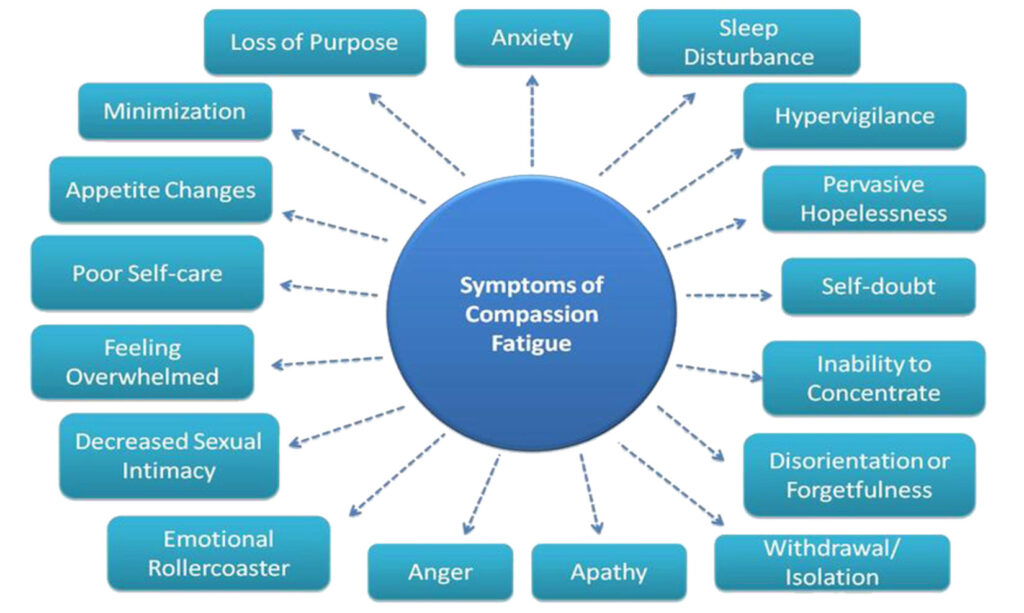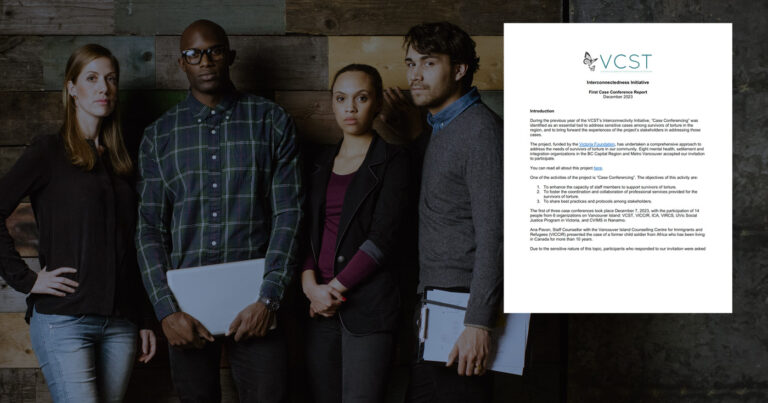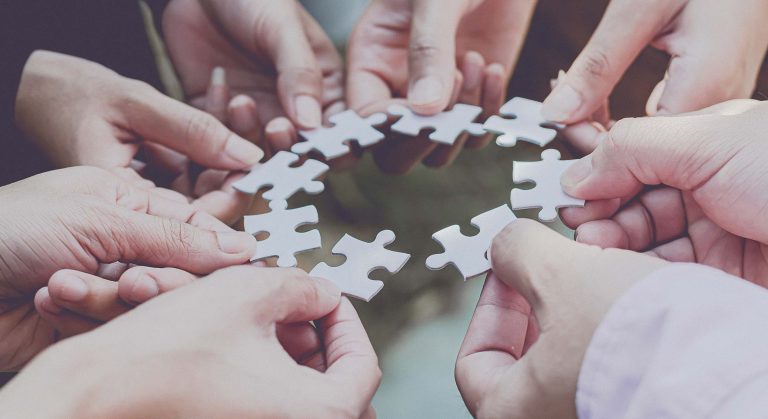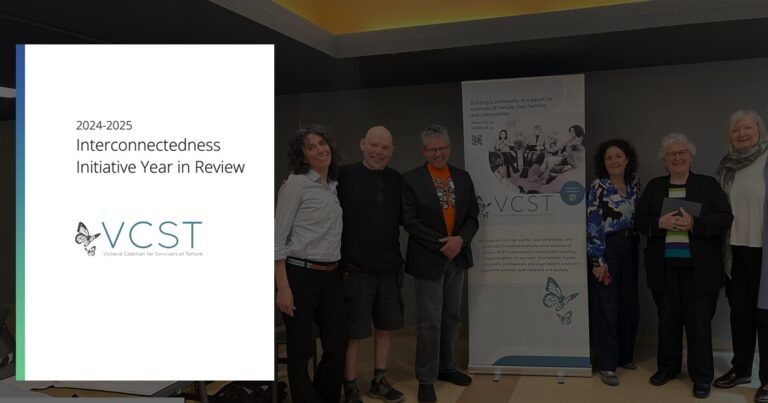Recap workshop: Understanding burnout, compassion fatigue and vicarious trauma
May 7, 2025 online
With Presenters: Dr. Yaya de Andrade and Ana Pavon
Introduction
As part of VCST’s Interconnectedness Initiative, on May 7, 2025, we welcomed 41 participants to our online workshop on understanding burnout, compassion fatigue, and vicarious trauma. Colleagues from seven different organizations attended from across the Greater Victoria area as well as Nanaimo and the Lower Mainland; attendees represented a range of organizations, including settlement and counselling agencies, victim services, and community services. In the workshop, we learned about identifying burnout, compassion fatigue, and vicarious trauma within ourselves and our organizations. We also learned some tips and tricks for managing these forces professionally and personally.
Our presenters were Dr. Yaya de Andrade and Ana Pavon. Yaya is a retired psychologist and a founding member of the Vancouver Association for Survivors of Torture and the Canadian Network for the Health and Human Rights of Survivors of Torture and Organized Violence. Ana is president of VCST and is a senior registered clinical counsellor, supervisor, and trainer at VICCIR (Vancouver Island Counselling Center for Immigrants and Refugees). Both presenters shared personal stories and experiences working with immigrants and refugees in mental wellness clinical settings in their long careers.
Ana started the workshop by defining some intersectional and systemic forces within the settlement sector that can compound burnout and compassion fatigue. For example, many settlement workers are immigrants or refugees themselves, with their own personal journeys and experiences of systemic and structural oppression and/or racism. They may experience conflicting cultural expectations as they navigate their new lives in Canada and careers within the North American workplace culture. These additional layers of experience will affect how someone experiences burnout and compassion fatigue.
Burnout vs compassion fatigue
Ana provided insights by clarifying the distinction between burnout and compassion fatigue. She explained that burnout typically arises from excessive workloads and insufficient resources—such as chronic underfunding, short-term contracts, and unstable work environments. In contrast, compassion fatigue stems from the emotional strain associated with caring for others, reflecting an accumulation of empathizing with those in distress, together with organizational culture and structural and societal factors.
Signs of burnout can include:
- Difficulty focusing
- Poor decision making
- Lower job satisfaction
- Tiredness
- Irritability
Signs of compassion fatigue can include:
- Anxiety
- Apathy
- Avoiding clients
- Detaching from clients
- Detaching from work for self-preservation
- Feeling drained
- Inability to concentrate
- Sleep disturbances

The three Rs
Ana shared a simple framework for working with burnout and compassion fatigue within ourselves: the 3 Rs. These are recognizing the signs/symptoms, such as those mentioned above; reversing the damage through specific self-care that works for each person; and building resilience over time through self-awareness.
Ana and Yaya emphasized the importance of self-reflection in building a personal tool kit for reversing burnout and compassion fatigue. They highlighted that burnout and compassion fatigue are expressions of systemic phenomena rooted in organizational structures, workplace culture, and societal factors—these are not merely the result of individual weakness or failure to cope. Our presenters emphasized that no universal solution exists, as each individual will have unique self-care needs and methods that work for their specific vulnerabilities. One participant shared that maintaining friendships and hobbies outside of work was essential to their well-being and ability to bring their best self to work. Yaya shared a story about a physical landmark she would pass on her commute home from work, which signalled to her that it was time to breathe and let go of work obligations for the moment. Yaya emphasized that the “solutions” are individual and can be mundane or straightforward—whatever works for you.
Other suggestions for self-care included:
- Exploring artistic expression, such as coloring or making art
- Listening to/making music
- Dancing and body movement
- Physical exercise
- Journaling
- Digital detox/work contact detox
- Connecting with friends and family
- Eating well
- Sleep and rest
- Seeking outside counselling or therapy
Vicarious trauma
Yaya presented on vicarious trauma (VT). This can happen to someone working with people who have been traumatized. The worker may vicariously experience their clients’ trauma by listening to their stories, interacting with their cases/files, accompanying them to medical/judicial appointments, etc. Many symptoms of VT are similar to those described for both burnout and compassion fatigue, with the source of the difficulty being the essential difference. VT can result from working with highly traumatized individuals and situations, such as working with survivors of torture in their settlement journeys, whereas burnout is more a result of insufficient support within a workplace. VT can result from a single incident, while burnout accumulates over time. A person can experience either condition independently, but everyone is susceptible to VT.
Further signs of VT include:
- Overidentification with the issues at hand
- Cannot stop thinking about the clients/case/problems
- Belief that they are the person to help, or may feel they cannot help at all
- Avoidance of the issues/clients/cases
- Loss of empathy
- Does not want to think about the client/case
Yaya emphasized the importance of self-awareness. Whether we are counselors, settlement workers, or clinicians, we all bring our personal stories and triggers to work, and our own unresolved personal issues can show up in our work in many ways. Again, self-awareness is key to understanding how and why VT is having an effect on you.
Actionable steps to reverse the effect of VT are similar to those for burnout and compassion fatigue mentioned above. Yaya introduced further elements of cultivating optimism, sustaining and renewing hope, and even consciously expanding our individual capacities for complexity. These personal growth concepts can put our work pressures into perspective in the balance of our individual lives.
Small group discussion
As part of the workshop, we divided the group into several smaller discussion groups. The groups were tasked with identifying two to three key priorities for discussion with the main group. After the small groups and a break, we gathered together again to spark a group discussion.
All the groups demonstrated deep familiarity with the topics and engagement with the personal, professional, organizational, and systemic issues. Many priorities were echoed across all the groups. For example, most groups shared a need for their organizations to provide more support for burnout, compassion fatigue, and VT. The groups expressed an awareness that these issues can come from within their own organizations. Many groups linked their support needs with the organizational need for trust building and accountability between workers, departments, and organizations; more flexibility within imposed policies; better funding; and an increased emphasis on humanity, not performativity and output.
Some ideas for solutions on the systemic/organizational level shared by the groups were:
- Regular supervision;
- Peer/leadership support;
- Care for employees and organizational awareness;
- Hiring and on-boarding (and on-going) practices that acknowledge compassion fatigue and VT with active organizational processes to support workers through these challenges; and
- Understanding and learning about boundaries of what an individual worker can do for an individual client vs what they can do against an entire system.
Closing remarks
We closed our workshop with a discussion about resilience, the last R in the 3 R framework introduced by Ana at the start. In response to the concept of “building resilience”—intentionally cultivating an ability to grow and thrive through challenges—Yaya reminded us that “if you are alive, you’re resilient.” This was a reminder that we are already resilient, in our own ways, even if we do not feel it; we are not somehow resilient deficient.
Ana’s pathways to enhancing resilience emphasized the importance of building community and networks at work and home. This is an interplay between employee and organization, wherein the organization supports the employee, such as through supervision, collaborative problem-solving, and a supportive workplace culture that acknowledges challenges, while the employee self-reflects on how to better support themselves through their own unique challenges.
The workshop provided an overview of how burnout, compassion fatigue, and VT show up in the personal and professional lives of people working with immigrants and refugees. Although the attendees represented a diverse range of organizations serving the general public, the group discussion highlighted a shared experience regarding these three significant concerns. We saw that many organizations have employees who are experiencing some or all three of these concerns, with people eager to learn strategies to help them cope personally. After establishing that dealing with burnout, compassion fatigue, and VT varies among individuals, the discussion turned to ways that organizations contribute to these issues and have a responsibility to their employees to be accountable for them.
The workshop’s high attendance and the group questions and priorities clearly show that much more work needs to be done to address burnout, compassion fatigue, and VT. VCST aims to continue supporting organizations as they work to better support their employees, who will, in turn, be better equipped to support their immigrant and refugee clients.






